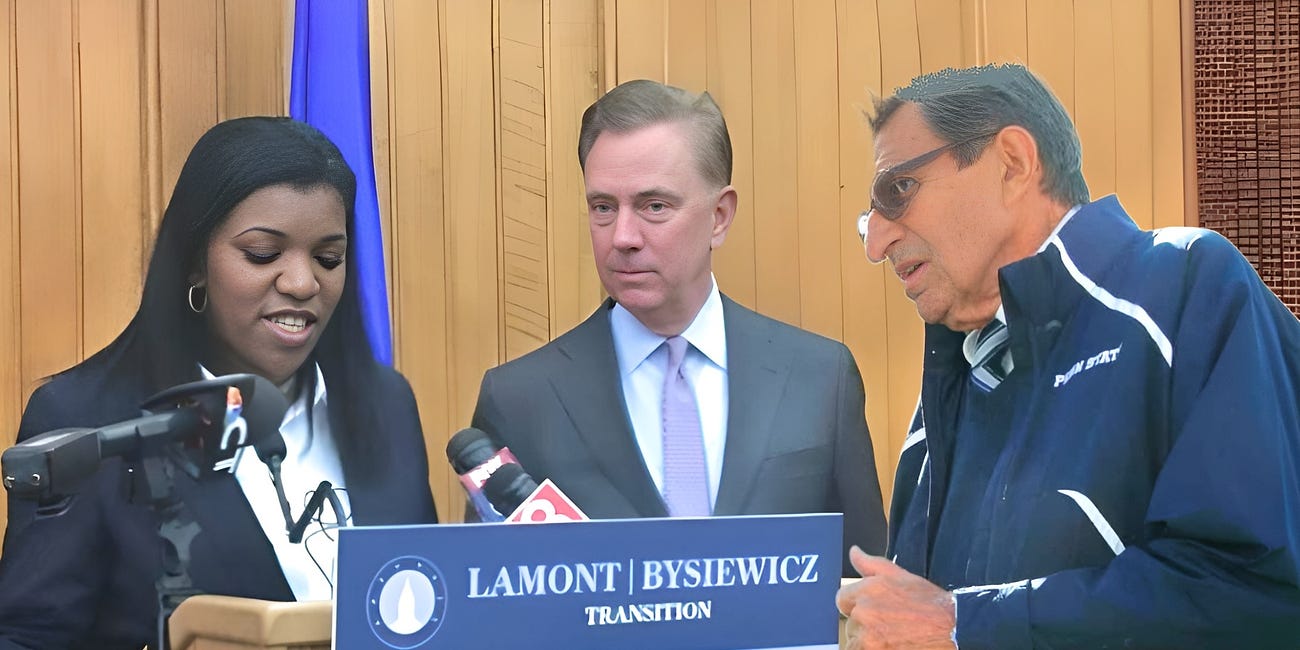BEANERS! [Video]: Child Molester Christopher Ambrose is Racist Too
White Ambrose Calls His Adopted Hispanic Children By Racist Names; Children Fleeing Sexual Abuse and Coercive Control
By Richard Luthmann
TikTok Influencer Robbie Harvey released shocking audio of psychopath and child molester Christopher Ambrose calling his adopted Hispanic children “BEANERS,” a derogatory term for persons of Latin American origin.
WATCH THE VIDEO HERE
Not only is Ambrose a dangerous sexual abuser, but he is also racist.
Rockland County, NY Child Protective Services has been notified about the fact that Ambrose has been crossing state lines from Connecticut to attempt to abscond with the Ambrose teenagers, who are now living with a relative, a respected martial arts instructor and wrestling coach in Congers, New York.
Rockland NY Child Protective Services "On Alert" For Pedo Christopher Ambrose
NOTE: This article was published on Frank Report (FrankReport.com) earlier today. I add additional information and context at the end.
The Ambrose teens have expressed a willingness to remain in Congers, New York, where they are safe. They want to go to school and start having normal teenage lives again.
Ambrose has been regularly crossing state lines into New York and seeking to abscond with the children, potential violations of New York and Federal law. He speaks with them, threatens them, and applies coercive control, which constitutes violent abuse under New York State law.
According to the Department of Justice, examples of abusive behavior include emotional, economic, and psychological abuse — any actions that "intimidate, manipulate, humiliate, isolate, frighten, terrorize, coerce, threaten, blame, hurt, injure, or wound someone."
New York Child Protective Services has jurisdiction over this case to protect the Ambrose teens. Will they act not just to protect these children but all children in Rockland County from Ambrose, a dangerous predator?

What will Rockland County Executive Ed Day say if a child (particularly a “Latin boy”) is sexually abused in Rockland County by Ambrose when CPS knows all about the danger? Is Ed Day the next Joe Paterno, who ignored the clear signs of Jerry Sandusky’s sexual abuse of minors?
Will Christopher Ambrose Become Connecticut DCF Commissioner Vanessa Dorantes' Larry Sandusky?
NOTE: This is a version of an article first published in Frank Report’s continuing coverage of Child Molester and Psychopath Christopher Ambrose of Madison, Connecticut.
What should happen to Rockland CPS officials if they do nothing? If they look the other way? You decide.
Supplement
A recent case in Brooklyn Family Court recently summarized the legal state of coercive control. The opinion was authored by “Murderous” Judge Eric Pitchal.
Judges Divorced From Justice: Is a Reckoning Coming to the New York Office of Court Administration?
By Richard Luthmann Ella Vitalis, a one-year-old from Brooklyn, will never see her second birthday. The cold factual narrative isn’t merely about her untimely demise but about the system that arguably played a part in her tragic fate. It’s a bleak reflection on the power wielded by the New York State Office of Court Administration (OCA) and its effect - …
On that case, of the dead one-year-old Ella Vitalis, I recently wrote:
The day before [Ella Vitalis] was found grievously injured, Brooklyn Family Court Judge Erik S. Pitchal had decided she should stay with her troubled parents - Lafayette Browne and Johnson Vitalis- despite their more than documented history of abuse.
Earlier, a domestic incident had sent Ella and her elder sibling to the hospital, subsequently being placed in relative foster care. Yet, replete with allegations and evidence of harm, the past didn’t deter Judge Pitchal. On June 15, 2023, he decreed that the children should return to their parents. This decision starkly opposed Children’s Services’ request to maintain the safety of the status quo.
“Murderous” Judge Pitchal’s poor judgment in the Vitalis case aside (I believe the New York Office of Court Administration should remove him form the bench), Pitchal’s reasoning on coercive control and domestic violence is sound in Matter of Aisha R.

Though the coercive control dynamic often applies between domestic partner relationships, coercive control is clearly applicable in the Ambrose case, particularly because the evidence shows Ambrose views his children as possessions and sexual objects.
Christopher Ambrose, through his actions, words, threats, and the available medical and clinical evidence, is, beyond the shadow of a doubt, a dangerous child molester and psychopath.
And Ambrose has committed these actions in the State of New York, giving authorities in Rockland County jurisdiction to act.
Matter of Aisha R. (Ariel T.), 79 Misc 3d 1106, 1109-1112 [Kings Cty. Fam Ct 2023]:
For over 15 years, scholars have understood that domestic violence is not limited to acts of overt physical aggression but rather can exist through the interpersonal relationship dynamics of two adults. One partner may exert coercion over the other, using "force or threats to compel or dispel a particular response." Evan Stark, Coercive Control: How Men Entrap Women in Personal Life 228 (2007). Independently, a relationship may feature one partner controlling the other, through "structural forms of deprivation, exploitation, and command that compel obedience indirectly." Id. at 229. Coercion and control can exist together, creating a "condition of unfreedom" also known as entrapment. Id. at 205.
Scholars analogize the circumstances of victims of coercive control to that of prisoners-of-war, hostages, and other "capture crimes":
The hostage analogy also illuminates the structural dimensions of battering that allow controllers to regulate a woman's behavior, including isolating them from sources of support; taking their money; depriving them of such necessities as food or medicine; suppressing conflict and resistance; cutting off opportunities for escape, communication, or transportation; and laying down and enforcing rules for everyday conduct.
Stark, supra at 205. Coercive control is a "particularly harmful form of domestic violence." Emma Katz, Beyond the Physical Incident Model: How Children Living with Domestic Violence are Harmed By and Resist Regimes of Coercive Control," 25 Child Abuse Rev. 46, 48 (2016).
It is known to involve a range of tactics intended to intimidate, humiliate, degrade, exploit, isolate, and control. These include verbal, emotional, and psychological abuse, control of time, space, and movement, continual monitoring, stalking, physical violence, intimidation and threats of violence against the victim/survivor, their loved ones and property, rape, sexual coerciveness and control of pregnancy, financial abuse and the denial of resources, and isolation from sources of support.
Id.(citations omitted).
The federal government and other nationally recognized sources affirm the basic observation that domestic violence is not always or only about physical aggression. The Department of Justice ("DOJ") defines domestic violence as "a pattern of abusive behavior in any relationship that is used by one partner to gain or maintain power and control over another intimate partner." See Department of Justice, Office on Violence Against Women, What is Domestic Violence, available at https://www.justice.gov/ovw/domestic-violence. The examples of abusive behavior include emotional, economic, and psychological abuse — any actions that "intimidate, manipulate, humiliate, isolate, frighten, terrorize, coerce, threaten, blame, hurt, injure, or wound someone." Id. The Centers for Disease Control and Prevention ("CDC") characterizes this as "psychological aggression," defined as the "use of verbal and non-verbal communication with the intent to a) harm another person mentally or emotionally, and/or b) exert control over another person." Matthew J. Breiding et al., Intimate Partner Violence Surveillance: Uniform Definitions and Recommended Data Elements 15 (2015), available at https://www.cdc.gov/violenceprevention/pdf/ipv/intimatepartnerviolence.pdf. These acts are "covert and manipulative in nature" and may not be seen as violent. Id. They include forms of expressive aggression, which encompasses name calling and humiliating the survivor, as well as coercive control, which encompasses limiting access to basic things such as money, friends, and family; excessively monitoring a person's whereabouts and communication without permission; and making threats to harm. Id.
In fact, the coercive and controlling behaviors which define emotional and psychological abuse are often precursors to more overt acts of aggression, such as physical and sexual violence, which sometimes come later and serve to reinforce the condition of unfreedom. Id.; see also Mayo Clinic, "Domestic Violence Against Women: Recognize Patters, Seek Help" available at https://www.mayoclinic.org/healthy-lifestyle/adult-health/in-depth/domestic-violence/art-20048397. These complicated dynamics are often represented visually in the well-known "Power and Control Wheel." See, e.g., National Domestic Violence Hotline, Break Free From Abuse, available at https://www.thehotline.org/identify-abuse/power-and-control/.
Courts have begun to recognize the non-physical aspects of domestic violence and to provide relief to survivors of coercive and controlling relationships just as if they had experienced physical injury. See, e.g., G.I. v. J.S., No. 16-37170, 2017 Del. Fam. Ct. LEXIS 36, 2017 WL 4792366 at *5 (Del. Fam. Ct. May 18, 2017); In re Joseph L., No. L15CP04007932A, 2006 Conn. Super. LEXIS 3034, 2006 WL 3008476, at *22 (Conn. Super. Ct. Sept. 15, 2006). The same relief is due in cases of expressive and psychological aggression as in those of physical aggression because the impact can be just as severe:
Coercive control can have devastating impacts on victims/survivors. In addition to its well-documented effects on physical and mental health, [researchers] highlight that coercive control limits victims'/survivors' space for action, that is their freedom to say and do things and to meet their own needs without worry or fear. As perpetrators microregulate their everyday behaviors, victims'/survivors' options, choices, and ability to decide for themselves diminish. These constraints on their agency and voice often contribute to a profound disempowerment, loss of self, and loss of confidence in victims/survivors.
Katz, supra at 48 (citations and internal quotation marks omitted).
Richard Luthmann is a writer, commentator, and investigative journalist with degrees from Columbia University and the University of Miami. A transplanted New Yorker, Luthmann is a member of the National Writers Union now living in Southwest Florida.
Check him out on Muck Rack.
“I am a journalist who writes about justice, the courts, government officials, prisons, and reform. You find some questionable players in all these places and often outright crooks. Exposing these bottom feeders from the outside is sometimes the only way to make them pay the price for their injustice, misdeeds, and tyranny.”
“I often use satire and opinion to make my point. I have already been told to ‘stop writing about the Government’ by the U.S. Government, so I must be doing something right.”
“If you’re a victim of the system, maybe the press is the right forum for you. If you have experienced injustice and are tired of dropping tens of thousands of dollars without results, maybe it’s time to try the digital pen.”
Contact Richard Luthmann at 239-631-5957 or richard.luthmann@protonmail.com.
"Nihil est incertius vulgo, nihil obscurius voluntate hominum, nihil fallacius ratione tota comitiorum.” (Nothing is more unpredictable than the mob, more obscure than public opinion, and more deceptive than the whole political system.)
~ Marcus Tullius Cicero
The news media is a critical check on the powerful, serving as a watchdog to hold elected officials and other public figures accountable for their actions. The media was first called the Fourth Estate in 1821 by Edmund Burke, who wanted to point out the power of the press. The press plays a crucial role in providing citizens with access to information about what is happening in government and by shining a light on corruption, abuse of power, and other forms of wrongdoing.








